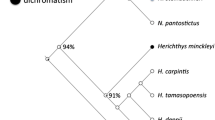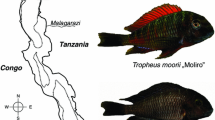Abstract
Extensive research has focused on understanding the evolution of parental care, with fishes providing important model systems for understanding patterns of variation within and between species. Classic theory predicts that individuals will care for offspring when the fitness benefits through increased offspring survival and growth outweigh the cost to the parents through decreased future reproductive opportunities. Yet, a puzzling observation not explained by this basic theory is the fact that in some species individuals defend and provision unrelated offspring and thus exhibit alloparental care. The tessellated darter, Etheostoma olmstedi, represents one of the first known examples of allopaternal care in fishes. In this species, males often clean and guard eggs fertilized but deserted by other males. Allopaternal care has been argued to occur in the tessellated darter because of competition for a limited number of mating sites where less dominant males accept territories with eggs when other breeding sites are not available. Here, we test this hypothesis using male territory choice experiments. When allowed to choose between two otherwise identical territories either containing eggs fertilized by another male or with no eggs, males spent significantly more time at territories with eggs. This demonstrates that competition for mating territories is not the primary factor explaining the existence of allopaternal care in the tessellated darter. Instead, males of this species may exhibit allopaternal care to dilute predator pressure on their own eggs or because females prefer to mate with males whose territories contain eggs.


Similar content being viewed by others
References
Constanz GD (1979) Social dynamics and parental care in the tessellated darter. Proc Acad Natl Sci Philadelphia 131:131–138
Constanz GD (1985) Alloparental care in the tessellated darter, Etheostoma olmstedi (Pisces: Percidae). Environ Biol Fishes 14:175–183
DeWoody JA, Fletcher DE, Wilkins SD, Avise JC (2000) Parentage and nest guarding in the tessellated darter (Etheostoma olmstedi) assayed by microsatellite markers (Perciformes: Percidae). Copeia 2000:740–747
DeWoody JA, Fletcher DE, Wilkins SD, Avise JC (2001) Genetic documentation of filial cannibalism in nature. Proc Natl Acad Sci U S A 98:5090–5092
Gross MR, Sargent RC (1985) The evolution of male and female parental care in fishes. Am Zool 25:807–822
Jamieson I (1995) Do female fish prefer to spawn in nests with eggs for reasons of mate choice copying or egg survival? Am Nat 145:824–832
Jamieson IG, Colgon PW (1992) Sneak spawning and egg stealing by male threespine sticklebacks. Can J Zool 70:963–967
Knouft JH, Page LM (2004) Nest defense against predators by the male fringed darter (Etheostoma crossopterum). Copeia:915–918
Knouft JH, Page LM, Plewa MJ (2003) Antimicrobial egg cleaning by the fringed darter (Perciformes: Percidae: Etheostoma crossopterum): implications of a novel component of parental care in fishes. Proc R Soc Lond., B Biol Sci 270:2405–2411
McKaye KR, McKaye NM (1977) Communal care and the kidnapping of young by parental cichlids. Evolution 31:674–681
Page LM (1983) Handbook of darters. TFH, Neptune City, p 271
Page LM, Schemske DW (1978) The effect of interspecific competition on the distribution and size of darters of the subgenus Catonotus (Percidae: Etheostoma). Copeia:406–412
Ridley M, Rechten C (1981) Female sticklebacks prefer to spawn with males whose nests contain eggs. Behaviour 76:152–161
Taborsky M (1994) Sneakers, satellites, and helpers: parasitic and cooperative behavior in fish reproduction. Adv Study Behav 23:1–100
Trivers RL (1972) Parental investment and sexual selection. In: Campbell B (ed) Sexual selection and the descent of man. Aldine-Atherton, Chicago, pp 136–179
Unger LM, Sargent RC (1988) Alloparental care in the fathead minnow, Pimephales promelas: female prefer males with eggs. Behav Ecol Sociobiol 23:27–32
Winn HE (1958) Comparative reproductive behavior and ecology of 14 species of darters (Pisces: Percidae). Ecol Monographs 28:156–191
Acknowledgements
We thank Joanne Klein for help collecting and maintaining the fish in captivity. We thank Mark Fisher, Erem Kazancioglu, Natasha Kelly, Holly Kindsvater and Stephen Stearns for advice and comments. We also thank two anonymous reviewers and Editor Noakes for helpful comments that improved the manuscript. Funding was provided by Yale University, a Howard Hughes Medical Institute Undergraduate Research Fellowship to MBF and NSF Grant IOB-0450807 to SHA.
Author information
Authors and Affiliations
Corresponding author
Rights and permissions
About this article
Cite this article
Farmer, M.B., Alonzo, S.H. Competition for territories does not explain allopaternal care in the tessellated darter. Environ Biol Fish 83, 391–395 (2008). https://doi.org/10.1007/s10641-008-9359-1
Received:
Accepted:
Published:
Issue Date:
DOI: https://doi.org/10.1007/s10641-008-9359-1




